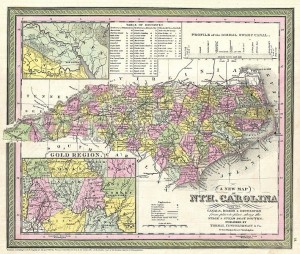by Jack El-Hai, Wonders & Marvels contributor
The California Gold Rush is famous for launching an army of wealth seekers toward the West Coast and establishing an important American presence on the Pacific. Between 1848 and 1855, panners and miners unearthed tens of billions of dollars in gold (in today’s dollars) in California and swelled the population of the region by 300,000.
Few know, however, that a half-century earlier and 3,000 miles away, a young boy’s fishing expedition started America’s first gold rush.
It began in 1799 in Mecklenburg (now Cabarrus) County in the Piedmont region of North Carolina, when 12-year-old Conrad Reed looked into Little Meadow Creek on his family’s property and saw an odd, shiny yellow rock. When he carried home the 17-pound chunk, his father, a Hessian veteran of the American Revolution named John Reed, thought it fit for nothing better than a doorstop. A few years later, though, the farmer took his son’s catch to a jeweler in Fayetteville, who shrewdly asked Reed how much he wanted for it. Reed naively proposed $3.50, and the bargain was made. The hunk of gold was actually worth nearly a thousand times more.
Reed soon learned he’d been hoodwinked, and he determined to find more gold on his property. He set up a mining operation on Little Meadow Creek that frequently turned up additional specimens of gold. The unearthing of a 28-pound nugget attracted gold hunters and the curious from far and wide. (President Thomas Jefferson arrived in 1804 to investigate the promise of a plentiful supply of gold.) Other successful mines sprang up in the surrounding counties, some of them venturing underground as well as along river beds, and the large local resource of gold inspired the U.S. government to open the first federal mint in nearby Charlotte in 1837.
A family legal dispute eventually idled the Reed Mine, but not before the semi-literate and relatively unskilled John Reed had become a wealthy man. North Carolina led the nation in gold production until 1848, when California took the lead. Not long after the California Gold Rush began, the Reed and its neighboring mines finally shut down. The Reed mine is now a North Carolina historic site where visitors can pan for gold, walk the abandoned mine tunnels, and explore Little Meadow Creek, whose ripples show little of the gold-seeking tumult that once roiled its waters.
Further reading:
Crayon, Porte. “The Gold Region.” Harper’s New Monthly Magazine, August 1857.
Hairr, John and Joey Powell. Gold Mines in North Carolina. Arcadia Publishing, 2004.

